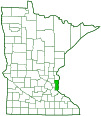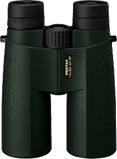Treehopper
(Cyrtolobus dixianus)
Conservation • Description • Habitat • Ecology • Distribution • Taxonomy
Conservation Status |
|||
| IUCN Red List | not listed |
||
| NatureServe | not listed |
||
| Minnesota | not listed |
||
Description
Cyrtolobus dixianus is a relatively small leafhopper. It occurs in eastern and central United States and Canada. It is uncommon throughout its range, including in Minnesota. It feeds on oak and will come to lights. Beyond that, nothing is known of this species life history or behavior.
Like all Cyrtolobus treehoppers, males and females have distinctly different forms. On the female, the head is slightly projected forward. The eyes are mostly yellow but reddish-brown in the center. The face between the eyes is only slightly wider than long. The edge of the cheek (gena) is strongly wavy.
The body is bright green, sometimes washed with bright yellow. When viewed from the front the upper part of the body (crest) is compressed, not rounded, and is strongly elevated.
The exoskeletal plate covering the thorax (pronotum) is bright green with many small white or pale green flecks. It is very long, extending back over the abdomen, and moderately arched, highest just before the middle. There is a large round depression (fovea) on the upperside, and the pronotum is slightly inflated before and after the fovea.
There are two pairs of wings, and they are held roof-like over the body when at rest. The forewings (hemelytra) are thickened, are longer than the body, and completely cover the sides of the body. The hemelytra are entirely clear and glassy or slightly tinged with yellow. They are comprised of a narrow area (clavus) behind the scutellum when the hemelytra are closed; and the remaining, broad, marginal area (corium). The veins are bright green and distinct. There is a horizontal vein crossing the corium that connects two longitudinal veins. The hindwings are thin, membranous, a little shorter than the hemelytra, and concealed beneath the hemelytra.
The legs are green. The claws are reddish.
The male is less arched. The back of the crest is white with a brown splotch toward the front, a broad brown band in the middle running from side to side, and a brown splotch at the tip.
Size
Male: 3⁄16″ (5 mm)
Female: ¼″ (6 to 7 mm)
Similar Species
Habitat
Ecology
Season
April through July
Behavior
Adults will readily come to light.
Life Cycle
Larva Food/Hosts
Adult Food
Oaks (Quercus spp.)
Distribution |
||
|
Sources |
|
| 11/23/2025 | ||
Occurrence |
||
|
||
Taxonomy
Order
Hemiptera (True bugs, Hoppers, Aphids, and Allies)
Suborder
Auchenorrhyncha (true hoppers)
Infraorder
Cicadomorpha (spittlebugs, cicadas, leafhoppers and treehoppers)
Superfamily
Membracoidea (leafhoppers and treehoppers)
Family
Membracidae (typical treehoppers)
Subfamily
Tribe
Smiliini
Genus
Subordinate Taxa
Synonyms
Common Names
None of the North American Cyrtolobus species have a common name. The common name of the family Membracidae is typical treehoppers, and it is applied here for convenience.
Glossary
Corium
The thickened basal portion of the front wing that lies between the clavus and the membrane of insects in the family Hemiptera. Plural: coria.
Gena
In insects: The area between the compound eye and the mandible; the cheek. In birds: The area between the the angle of the jaw and the bill; the feathered side (outside) of the under mandible. Plural: genae.
Hemelytron
The forewing of true bugs (order Hemiptera), thickened at the base and membranous at the tip. Plural: hemelytra.
Pronotum
The exoskeletal plate on the upper side of the first segment of the thorax of an insect.
Visitor Photos
Share your photo of this insect.
This button not working for you?
Simply email us at info@MinnesotaSeasons.com.
Attach one or more photos and, if you like, a caption.
Alfredo Colon |
||
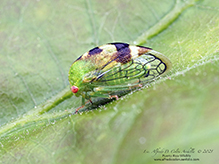 |
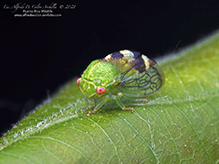 |
|
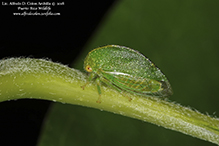 |
||
MinnesotaSeasons.com Photos
|
|

Slideshows
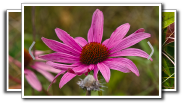
Visitor Videos
Share your video of this insect.
This button not working for you?
Simply email us at info@MinnesotaSeasons.com.
Attach a video, a YouTube link, or a cloud storage link.
Other Videos

